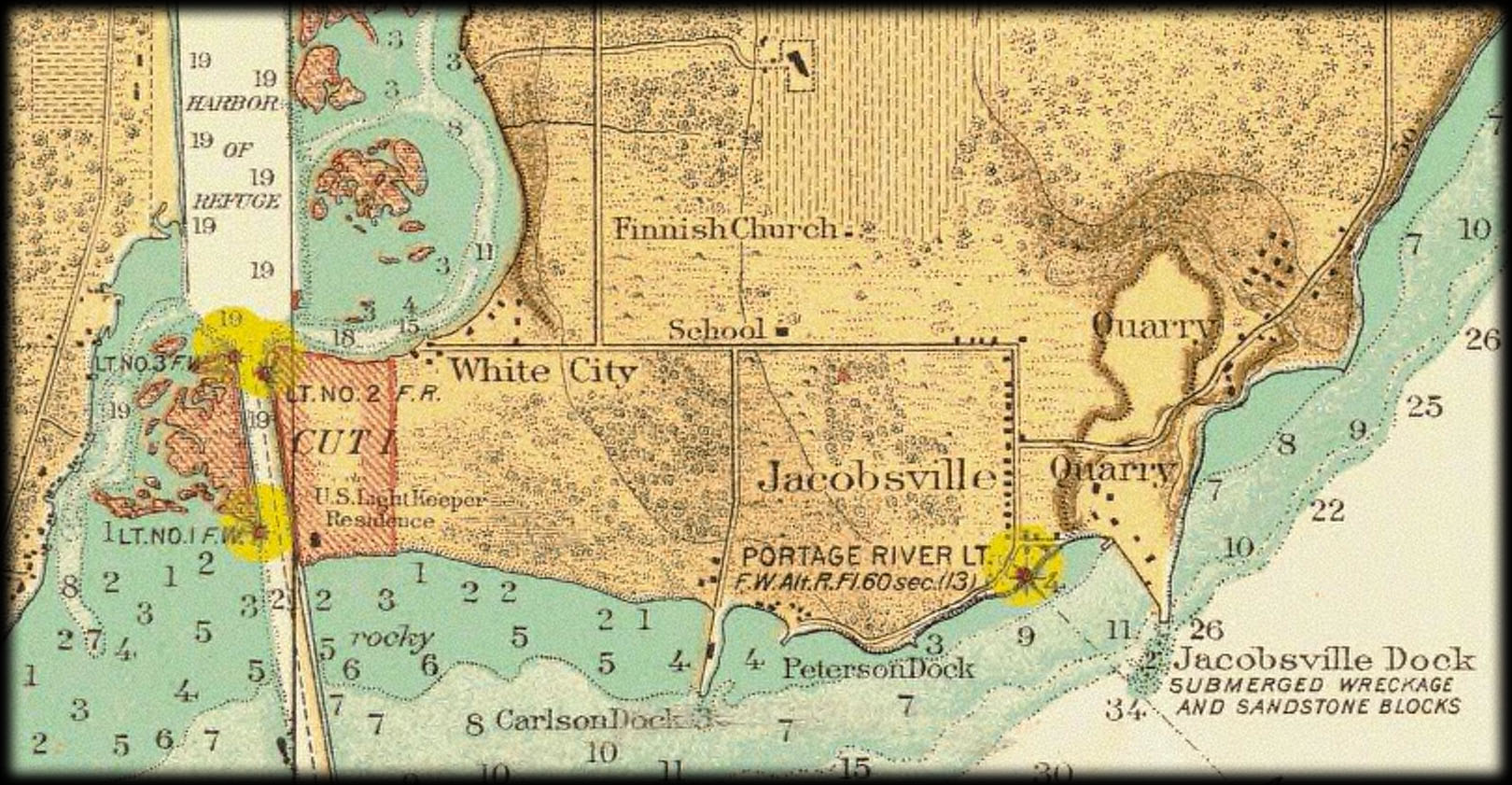
This sumer we were visited by Joshua Richardson, a geology graduate student at Michigan Tech University with expertise in Keweenaw Peninsula geology and, specifically, Jacobsville Sandstone. After making the crossing from Rabbit Bay we hiked around the island for an afternoon while he jotted down some field notes. A few weeks ago he emailed us this summary of his observations. It is fascinating. For one, the island was formed between 900 million and 1.6 billion years ago by the deposition of sand at the bottom of ancient streams, much like what can be seen in glaciated areas of Alaska today. Also, towards the bottom of his summary, he offers advice on which sandstones are the most suitable for building applications and which ones would be best for stove/sauna applications where heat and fire are factors. This info is invaluable from the perspective of attempting to not make brick-and-mortar mistakes while designing and building and will hopefully allow us to create simple structures that will stand the test of time using the best local stones available. Exciting stuff. Thanks Josh.
Dear Rob, Andrew,
I have compiled what I feel comprises a short description of the geology observed at Rabbit Island. Although I was unable to ascertain the existence of the island, there were several features that are interesting. Also, I have done some brief research to add to and correct the observations that I made based off of extensive research previously conducted on the Jacobsville Sandstone.
The Jacobsville Sandstone was deposited in the Middle Proterozoic, corresponding to an age from 1.6 billion to 900 million years before present. On the south-eastern shore of the Keweenaw, including Rabbit Island, the sandstone unit is greater than 1000 feet thick, decreasing in thickness to the southeast. While the unit as a whole is considered a sandstone, sub-units consist of siltstone (mud), conglomerate (mud with pebbles and boulders), and shale (really fine mud). On Rabbit island, siltstone and sandstone are both abundant, as characterized by solid sandstone rock (red and white), and loose, highly eroding siltstone layers (green and red to black). On Rabbit Island, some portions of the sandstone appear to have been metamorphosed (heated and pressurized, recrystallized), and turned into a quartzite, which is slightly harder than the original sandstone, but made of the same minerals as a whole. This reheating and pressurization is a result of hot fluids passing through the rock, also producing the small yet visible quartz crystals that are found throughout the island in small cracks.
The Jacobsville Sandstone on Rabbit island is made up mostly of quartz, with a minor amount of potassium-feldspar (mineral found in igneous rocks), clays, and some minor hematite (natural rust, or iron oxide mineral). The red color is caused by both the coloration of potassium feldspar and hematite. Where the sandstone is white, it is made of almost entirely quartz (SiO2), and where it is very weathered looking and soft, that is mostly clay minerals which do not hold up very well with time, and can gain and lose water from their structures.
The sandstone on Rabbit Island was probably formed by a very wide, shallow delta of large braided streams and rivers flowing into a shallow sea (like what exists in Alaska today), but may also have contributions from wave action on an ancient beach. In any case, the sandiest parts of the sandstone (white colored) on the island were probably deposited by fast flowing rivers and tidal currents, and the very fine grain (silty, dirty looking rock), by very slow or stagnant water, where the fine particles could settle out.
There are a few interesting sedimentary structures on the island, including both ripple marks and cross-bedding (or cross-lamination). The preserved ripple marks, observable near the boat access area near the main camp, as well as in other places too, are exactly the same as those seen on the bottom of the sandy beaches of Rabbit Bay, or in local sandy river bottoms, although about 1 billion years old. Ripple marks are only preserved when other sediment is quickly deposited on top of them, because the continuing river action will constantly erode and redeposit the sand. They are only found when a changing current situation happens and the energy of the water in a channel is reduced (i.e. silt is deposited on top of the ripple marks after a channel becomes partially cut off from the rest of the river and the current slows.)
The cross-bedding (cross-lamination) is found throughout the island, and consists of thin dipping layers that are not parallel to the usual bedding planes of the sandstone. Sometimes they are found with alternating red and white layers, that appear much steeper than the rest of the bedding of the island. These are useful, as the direction that these small layers or laminations are dipping tells the direction that the current was flowing when these silts and sands were deposited. These can be found all over on the island. If one were to carefully measure all of the cross-bedding directions on the island, one could ascertain the direction of the paleocurrent (literally “old current”).
In addition to sedimentary structures, the island is filled with joints of various ages. A joint simply occurs when the rock is strained to the point of breaking by regional and local stresses. Instead of faulting, where two halves of the rock move in opposite directions relative to each other, a joint simply implies a crack in the rock that opens, but where no slip occurs. On the island, the cracks (joints) in the rock that are filled with a white quartz through a generally red rock are the result of joints that were formed during the movement of hot fluids through the rock. When the joint formed due to stresses, the hot fluids with SiO2 (quartz) were quick to “heal” the crack in the rock and fill in the voids. Joints that are open cracks have been formed since the rock was cool, so they remain open and fluids with SiO2 (quartz) were not available to fill in the open spaces. Many of the joints that didn’t entirely fill up with quartz may have quartz crystals, some of which are laying around camp.
In addition to rocks formed in the Keweenaw, some rocks have been transported to the island by ice-rafting (ice sheets moving rocks and debris) from Canada. These include igneous intrusives (igneous rocks that cooled very slowly, deep within the earth, only exposed later due to weathering) like granite (pink, white, and black), gabbro (black, with many reflective larger grains), and andesite and dacite (white and black mix). There may also be some igneous extrusives too (rocks that were erupted from volcanoes like lavas, and cooled rather quickly) including rhyolite (red) and basalt lava (black, the same as the Keweenaw interior rocks).
You had also asked which rocks would make the must durable building material. Regarding this the best building stones on the island would be the white or pinkish-red sandstone. It is found all over the island, but some great samples of it are right at the boat launch. That material is hard and resistant to weathering. Avoid the softer clay units within the sandstone, since as walking around the island will show, they fall apart rather readily with the weather. The unit right by the boat launch could also be broken into nice brick shaped pieces for stacking into a structure too.
For fire/sauna rocks, the best rocks are probably the Canadian igneous rocks that wash up on the shores. Since they are few and far between, I would again pick the white or pinkish sandstone rocks that have no clay minerals (soft red,green or black). These clay based minerals have water in the structure, and will likely release the water when heated, causing violent explosions. This would be less than ideal.
I am not certain about this, but I think the abundance of rubble around the island is more of a function of currents and ice patterns than the structure of the island and strength of rocks. The larger boulders and rubble are found in areas where the waves are the fiercest, and the smaller pebbles are found where the shoreline is more sheltered, for example the one bay that we visited.
Josh Richardson
jprichar@mtu.edu
